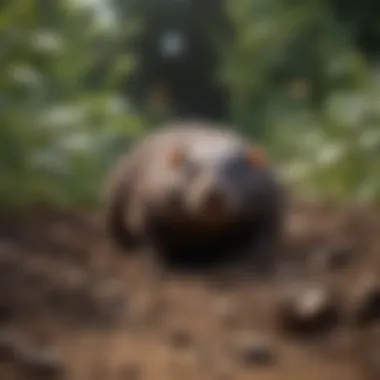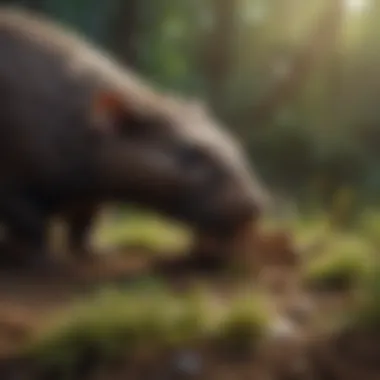Understanding the Factors Behind Mole Mortality


Intro
Moles are often perceived as pests, but they are also essential for soil aeration and pest control. As we analyze the factors contributing to their deaths, it becomes clear that their life cycle and habitat directly influence their survival. In this segment, we will discuss critical points that will unfold throughout this article.
- The ecological role of moles in soil ecosystems.
- The biological vulnerabilities that moles face.
- Environmental conditions that could threaten their survival.
- The implications of mole control for homeowners and gardens.
With a deep dive into these elements, we aim to enrich the reader's understanding of moles and their ecological significance.
Prelims to Moles
Understanding moles is essential for anyone interested in garden care and property management. These small, burrowing mammals play significant roles in soil aeration and pest control; however, their activities can also lead to disputes with homeowners. This amount of influence they exert on the ecosystem cannot be overstated. Therefore, comprehending their lifecycle, ecology, and the factors that affect their mortality becomes incredibly valuable.
Moles live beneath the soil. Their tunnels serve as habitats for various creatures and as pathways for water and nutrients. Understanding the mole's lifestyle is not just an intellectual exercise but a practical necessity for effective land management. Knowledge of their biology and the natural pressures they face allows homeowners to make informed choices regarding their presence in residential areas.
Understanding the Mole's Ecology
Moles inhabit a variety of environments, ranging from grasslands to forests. They are primarily found in moist, loose soils that are rich in invertebrate food sources such as earthworms and grubs. Their burrowing nature contributes to the health of the soil by aerating it and mixing organic matter, which enhances fertility. However, these creatures engage in modified behaviors during seasonal changes, reflecting their adaptability to different ecological pressures.
Ecologically, moles are crucial for pest control. They consume vast quantities of pests that can harm garden plants, making them allies to gardeners. Yet, their activity can cause significant soil displacement, attracting criticism from individuals focused on aesthetics and lawn care. Their roles, both beneficial and detrimental, create a complex relationship between homeowners and these small mammals.
Physical Characteristics of Moles
Moles possess specialized adaptations for their subterranean lifestyle. Their bodies are compact, featuring cylindrical shapes that reduce drag as they move through soil. Fur-covered skin allows for easy movement in both directions, which is important for evading predators.
The forelimbs of moles are particularly noteworthy. With large, spade-like muscles, they are adapted for digging. These limbs provide force and leverage, enabling moles to create extensive tunnel systems that can spread over considerable distances. Additionally, their eyes are small and often hidden beneath fur, which minimizes exposure while moving underground. This design indicates a reliance on other senses, such as touch and smell, to navigate their environment. Ultimately, understanding these physical traits elucidates how moles survive in buried ecosystems.
Key Point: Moles contribute fundamentally to soil health, but their impact on gardens can lead to conflicts with homeowners. Recognizing both sides of this relationship is crucial for effective garden management.
Life Cycle of Moles
Understanding the life cycle of moles is crucial for informing conservation efforts and control methods. The life cycle encompasses various stages, from reproduction to maturity. Each stage affects their population dynamics and mortality risks. Awareness of this cycle helps homeowners make informed decisions about managing these animals in their gardens or yards, fostering a balanced approach to coexistence.
Reproduction and Growth
Moles reproduce throughout the spring and early summer. During this period, males establish territories that attract females. After mating, the gestation period lasts about 4 to 6 weeks. A female mole can give birth to an average of 3 to 5 pups per litter. The young are born blind and helpless, relying solely on their mother for nourishment.
As the pups develop, they grow fur and begin to explore their surroundings at around three weeks of age. By the age of 4 to 6 weeks, they start to dig and forage alongside their mother. This stage is critical, as it teaches them essential survival skills. After approximately two months, the young moles are weaned and must find habitats of their own.
Each year, this cycle repeats, perpetuating the population. Factors such as resource availability and predation impact how many survive the transition to adulthood. Knowledge of these reproductive habits can aid in understanding fluctuations in mole populations.
Habitat Preferences
Moles have specific habitat requirements that dictate their survival. They prefer moist, loose soil, which facilitates tunneling and foraging. Areas with ample earthworms and grubs are ideal since these are their primary food sources.
Mole habitats often include:
- Lawns: Well-watered grass allows for easy digging and nutrient access.
- Gardens: Rich soil provides abundant food and shelter.
- Forested areas: Wet, loose ground in woods supports their tunneling behaviors.


Environmental conditions influence their distribution. For instance, heavy rains can affect soil quality, leading to changes in mole populations. Habitat loss due to urban development poses severe threats. As their natural environments disappear, moles find it increasingly difficult to survive. Understanding these habitat preferences is vital for effective management practices.
Moles play a significant ecological role. Their burrowing aerates the soil and helps in nutrient recycling, making their presence valuable even in agricultural contexts.
Natural Predators of Moles
Understanding the role of natural predators in the lifecycle of moles is vital. These predators significantly influence mole populations and their behaviors. Natural predation acts as a form of population control. Without these predators, mole populations might grow unchecked, leading to imbalances in their habitats. Homeowners may find this aspect particularly relevant when addressing mole presence in gardens and lawns. Knowing which animals prey on moles can inform control decisions and mitigation strategies.
Common Predators
Various animals are known to prey on moles. Some of the most common predators include:
- Owls: These nocturnal birds are skilled hunters. Their keen eyesight allows them to spot moles in the dark, making them one of the primary threats to mole populations.
- Foxes: Foxes are opportunistic hunters. They hunt moles primarily during dawn or dusk, utilizing their sharp senses and agility.
- Coyotes: In some regions, coyotes may pursue moles as part of a varied diet. Their adaptability means that they can locate moles in different environments.
- Domestic cats: In residential areas, cats often catch moles that venture too close to the surface.
- Rodents: Larger rodents, such as weasels, may also hunt small moles, although this is less common.
These predators can significantly impact mole numbers and behaviors, driving them to burrow deeper and create more complex tunnels.
Impact of Predation on Populations
Predation shapes mole behavior and ecology. Several points highlight the influence of predators on mole populations:
- Survival Rates: Predators reduce mole survival rates. Young moles are particularly vulnerable. Hence, a higher predator presence can lead to fewer moles reaching adulthood.
- Habitat Alterations: The pressure from predators may force moles to adapt their tunneling habits. Moles may dig deeper or change the timing of their foraging activities to avoid detection.
- Population Dynamics: Predation can lead to cyclical population dynamics. If predator numbers rise, mole populations may decline. Conversely, if moles are scarce, predators might reduce in number too.
- Ecosystem Balance: The presence of natural predators contributes to a balanced ecosystem. They help maintain mole populations within a sustainable range, preventing overpopulation and habitat degradation.
"Natural predators play a critical role in maintaining ecological balance, acting as both population controllers and indicators of ecosystem health."
Understanding these relationships aids in managing wildlife effectively. For homeowners, being aware of predation can help in formulating informed strategies to deal with moles.
Diseases and Parasites
Understanding the impact of diseases and parasites on moles is crucial in exploring what contributes to their mortality. These biological threats can significantly reduce mole populations and lead to population imbalances within ecosystems. By recognizing common diseases and the role of parasites, we can better comprehend how these factors impact moles directly and indirectly.
Common Diseases Affecting Moles
Moles are susceptible to several diseases that may lead to their decline. Among these, diseases caused by bacteria and viruses are notable.
- Mole-specific Bacterial Infections: Bacterial infections can infiltrate through cuts when moles dig in soil. This can result in systemic infections, affecting vital organs.
- Fungal Infections: Fungus can also attack moles, particularly in wet conditions. Such infections can cause skin lesions, weakening the mole’s health and ability to sustain life.
- Viral Infections: Viruses can spread quickly through populations. Though specific viral diseases affecting moles are not widely documented, it is believed they exist and can lead to high mortality.
These diseases often compromise moles' immune systems, making it harder for them to fend off other threats such as predators and environmental changes. A sick mole may also be less effective in foraging, leading to malnutrition and further jeopardizing their survival.
Parasites and Their Effects
Parasites exert a notable influence on mole populations. They thrive by exploiting host organisms, and moles are no exception.
- External Parasites: Fleas and ticks can latch onto moles, draining their energy and causing irritation. This discomfort may lead moles to abandon their usual habitats, pushing them into more vulnerable areas.
- Internal Parasites: Roundworms and flatworms can invade moles’ gastrointestinal systems. They can cause significant nutritional deficits, ultimately leading to poor health and death over time.
"Parasites often weaken their hosts, sometimes leading to subsequent mortality due to related health issues or exposing them to predators."
The presence of parasites can lead to a decline in reproduction rates. When host moles are burdened by these organisms, they may be less inclined or able to reproduce successfully. Thus, both health and population numbers are deeply impacted.
The interplay between diseases and parasites depicts a complex web of challenges faced by moles. Homeowners, particularly those in urban areas, need to recognize these factors in order to understand mole populations in their gardens. Awareness may lead to better management strategies that uphold ecological balance while addressing control measures.


Environmental Factors Leading to Mole Mortality
Understanding the environmental factors that lead to mole mortality is crucial in grasping the broader implications of mole populations within ecosystems. These factors include varied influences such as climate change and soil quality, both of which are essential to the moles' survival and reproductive success. By recognizing how these environmental conditions affect moles, homeowners and gardeners can better appreciate their role in the ecological balance and the significant consequences of altering such factors.
Climate Change Impacts
Climate change fundamentally alters habitats and has profound effects on wildlife. For moles, rising temperatures, changing precipitation patterns, and extreme weather events can directly affect their survival. Increased temperatures can lead to droughts, which affect the moisture levels in soils where moles dig and create their tunnels. Without the right soil conditions, food sources become scarce.
Changes in weather patterns can also disrupt the hibernation cycles of moles. Moles rely heavily on a consistent environment to thrive. Abrupt temperature fluctuations may lead to confusion in their biological rhythms, causing failure in reproduction or direct mortality due to exposure to unsuited weather.
Homeowners often need to recognize that these climatic shifts not only affect moles' habitats but also their behavior and survival strategies. Researching and implementing sustainable practices in gardens can help mitigate some of these adverse effects.
Soil Quality and Its Importance
Soil quality is a critical factor in the overall health of mole populations. Healthy soils promote a rich environment for the small insects and organisms that moles primarily feed on. Compacted or polluted soils can lead to reduced food availability, which is detrimental to moles.
Factors such as pesticide use, urbanization, and other forms of land misuse degrade soil quality. This degradation not only diminishes food sources for moles but can also affect their burrowing behavior. Moles require specific soil textures to effectively create their tunnels. If the soil is too hard or too saturated, it becomes increasingly challenging for moles to dig, leading to decreased activity and higher mortality rates.
Human Impact on Mole Populations
Human activities significantly impact mole populations, often leading to their decline. Understanding these effects is crucial for anyone interested in ecology, gardening, or pest control. Awareness of how human actions influence moles can guide homeowners in making informed decisions about their gardens, lawns, and landscapes. This section covers two main aspects: urban development and habitat destruction, as well as the use of chemical controls.
Urban Development and Habitat Destruction
Urban development poses a severe threat to moles. As cities expand, natural habitats are often replaced with concrete, buildings, and roads. This transformation leads to a significant loss of suitable living conditions for moles. They typically inhabit areas with ample soil to burrow and hunt for food. As their environments vanish, the struggle for survival intensifies.
The effects of habitat destruction are not limited to physical space. It alters the food web, affecting the availability of insects and earthworms that moles rely upon. Consequently, the decline in these food sources can lead to reduced population sizes. Homeowners may also notice that moles relocate to less suitable areas, often leading to more visible signs of mole activity in yards and gardens, which can be frustrating for those trying to maintain a pristine outdoor space.
Use of Chemical Controls
Another factor affecting mole populations is the use of chemical controls. Homeowners may resort to pesticides or other chemicals in an attempt to manage what they perceive as a pest problem. However, these solutions can be counterproductive. The application of toxic chemicals can harm not only moles but also beneficial insects and other wildlife, disrupting the ecosystem.
Moreover, the overreliance on chemical solutions often leads to increased soil contamination. This contamination affects soil health, diminishing its ability to support diverse plant and animal life. Homeowners might find that while they may eliminate some moles initially, the long-term impacts of chemical controls can lead to more significant ecological imbalances.
The interaction of urbanization and chemical interventions creates a challenging environment for moles, requiring a careful balance between human needs and ecological health.
In summary, understanding the human impact on mole populations is essential. Urban development and habitat destruction reduce living space and food availability. The use of chemicals often complicates these challenges further. For homeowners, adopting more environmentally friendly methods can help ensure that moles and the delicate ecosystems they inhabit can thrive. This not only respects wildlife but also fosters a more balanced garden environment.
Assessment of Mole Control Methods
The assessment of mole control methods is crucial in understanding how to manage mole populations effectively. Not only does it involve evaluating the effectiveness of various control techniques, but it also considers their impact on the local ecosystem. Homeowners and gardening enthusiasts often encounter moles as they work to maintain their gardens and lawns. Therefore, knowing how to deal with these creatures responsibly can help in preserving the ecological balance, while still achieving desired garden aesthetics.
In assessing control methods, it is important to weigh ecological implications against practical effectiveness. Informing readers about humane options versus aggressive ones is vital, as this can shape attitudes towards wildlife management. Employing strategies that align with environmental stewardship can lead to beneficial outcomes for both humans and moles.
Humane Control Techniques
Humane control techniques prioritize the well-being of moles while addressing the concerns of homeowners. These methods focus on deterrence rather than elimination, creating a more sustainable approach to mole management. Some effective methods include:
- Natural Barriers: Installing physical barriers, like underground fencing, can prevent moles from entering specific areas. Using materials that discourage digging is vital.
- Planting Specific Flora: Certain plants, such as daffodils and marigolds, are known to repel moles due to their scent. Incorporating these into garden designs may help keep moles at bay.
- Repellents: There are several natural repellents, such as castor oil, that can be applied to soil, potentially discouraging moles from tunneling.
- Habitat Modification: Reducing the availability of food sources for moles, such as grubs and earthworms, can make the environment less appealing to them.


By adopting these techniques, homeowners can manage mole populations more ethically, while still protecting their gardens.
Aggressive Control Measures
Aggressive control measures, while often effective in reducing mole populations, can have significant environmental repercussions. It is essential to understand these impacts and consider them before determining a course of action. Common aggressive methods include:
- Trapping: This is one of the most effective ways to control moles. Different types of traps, like scissor traps or harpoon traps, can efficiently capture moles without the use of poisons. However, knowing how to set them correctly is vital for success.
- Pesticides: Chemical controls, though typically effective, pose risks to non-target species and the local environment. Using these options should be a last resort and done with extreme caution.
- Poison Baits: Similar to pesticides, poison baits can lead to unintended consequences for other wildlife. They require careful application and monitoring.
"Understanding the implications of aggressive methods is essential for responsible mole management."
Homeowners must weigh the potential short-term benefits of these measures against the long-term effects on the local ecosystem. It is often beneficial to explore humane alternatives first before resorting to aggressive techniques, fostering a more harmonious relationship with local wildlife.
By examining both humane and aggressive control methods, readers can make informed decisions that align with their values and gardening goals. The right choice can vary based on individual circumstances, but awareness of the implications of each method is key to fostering sustainable practices.
Conservation Considerations
Conservation considerations are crucial when discussing the factors that lead to the mortality of moles. As integral parts of their ecosystems, moles contribute significantly to soil health and the biodiversity within their habitats. Understanding their role in ecosystems can guide effective conservation strategies that do not merely focus on eradication but also on maintaining balance in the environment.
Role of Moles in Ecosystems
Moles play a vital part in soil aeration and nutrient cycling. Their burrowing activities help to mix organic matter into the soil, promoting healthy root development for various plants. The tunnels they create are also beneficial for other wildlife, allowing water penetration and enabling various organisms to thrive. Furthermore, moles consume insects and larvae, thus reducing pest populations in gardens and agricultural fields.
"Moles are not just pests; they are ecosystem engineers that facilitate nutrient cycling and improve soil structure."
In essence, moles help sustain the health of their environment, which indirectly benefits agricultural practices and natural landscapes alike. Their presence indicates a thriving ecosystem, a signal that the environment is functioning as it should.
Balancing Control and Conservation
Balancing control measures with conservation is a complex yet essential endeavor. Homeowners often seek ways to manage mole populations due to the visible effects of their activities, such as raised mounds in gardens and lawns. However, it is crucial to recognize that moles possess ecological value.
Some humane control techniques include:
- Utilizing natural repellents, which may deter moles without harming them.
- Implementing habitat modification strategies to make areas less conducive for mole habitation.
- Encouraging natural predators such as owls and hawks by creating conducive environments for these species.
On the other hand, aggressive control measures like poisons can lead to unintended consequences. The chemicals may not only kill moles but also affect other non-target species, thereby disrupting the ecosystem. Thus, any control method should be carefully evaluated considering the potential ecological ramifications. By understanding the importance of moles in the ecosystem, individuals can make informed decisions that harmonize control efforts with conservation goals.
Ending
The conclusion of this article serves as an important synthesis of the key insights regarding the various factors that lead to the death of moles. It allows readers to reflect on the ecological and biological aspects of mole mortality. Understanding these elements is paramount for homeowners and gardening enthusiasts who may face mole-related issues in their own backyards.
Summarizing Key Points
In reviewing the critical components discussed throughout this article, several key points emerge:
- Ecological Role: Moles play a significant role in soil aeration and pest control. Their existence helps maintain ecosystem balance.
- Predation: Natural predators like hawks, foxes, and snakes have a substantial impact on mole populations, highlighting a biological threat.
- Diseases and Parasites: Various diseases and parasitic infestations can significantly affect their health and survival rates.
- Environmental Influences: Factors such as climate change and soil quality are vital to understanding how environmental changes can threaten mole populations, leading to increased mortality.
- Human Activity: Urban development and the use of chemical controls can adversely impact moles, disrupting their habitats and leading to fatalities.
"Awareness about mole mortality factors equips homeowners with the knowledge to approach mole control responsibly."
Future Research Directions
Future research in the domain of mole ecology and mortality should emphasize several areas:
- Longitudinal Studies: Investigating the long-term effects of environmental shifts on mole behavior and population dynamics is essential. This data can enhance our understanding of how moles adapt to changing conditions.
- Impact Assessment of Chemical Controls: Thorough examination of how various pest control methods affect not only moles but the broader ecosystem.
- Habitat Restoration: Researching methods for mitigating habitat destruction caused by urban expansion could foster healthy mole populations.
- Disease Monitoring: A focused study on the prevalence and spread of diseases among mole populations to create effective management strategies.
- Predation Dynamics: Understanding the intricate relationships between moles and their predators could provide insight into natural population controls.
By directing research resources toward these objectives, we can contribute to the conservation of moles and promote ecological balance while providing guidelines for sustainable interaction with wildlife.















